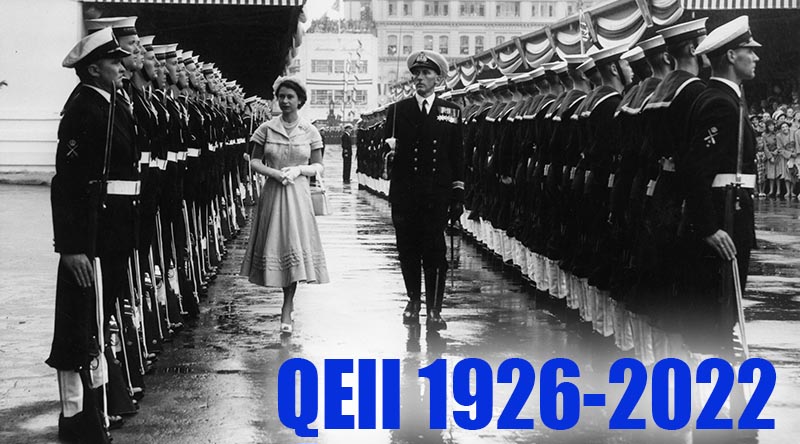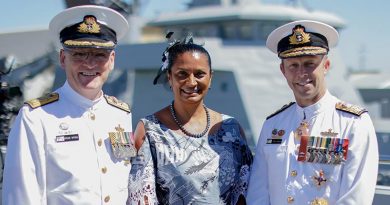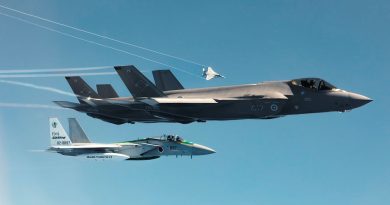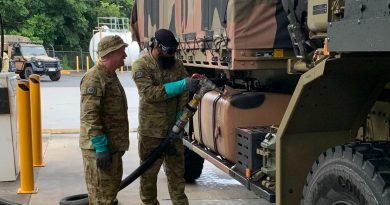New Zealand Defence Force marks passing of Queen Elizabeth II
Share the post "New Zealand Defence Force marks passing of Queen Elizabeth II"

Buckingham Palace released a statement just after 6:30pm local time on Thursday 8 September 2022 – 3:30am Friday in Sydney and 1:30am in Wellington – confirming that Queen Elizabeth II had died at her Balmoral estate in the Scottish Highlands.
The New Zealand Defence Force was quick to acknowledge the passing of The Commonwealth’s longest-reigning monarch, who had many deep and abiding ties with New Zealand’s military forces.
Chief of Defence Force Air Marshal Kevin Short said Her Majesty’s ongoing dedication to her duties was an inspiration to the NZDF, particularly in the challenging times throughout her reign.
“Her dedication and commitment resonated with us all as it is the ultimate example of service which underpins everything we do as members of the New Zealand Defence Force,” he said.
A 96-round Death Gun Salute marking the passing of Queen Elizabeth II
was live-streamed from Wellington. Visuals start around 14 minutes into video.
Gun Salute starts around 42 minutes into video.
“While there will be a sombre mood acknowledging Her Majesty’s death, it is also a time to appropriately celebrate her more than 70 years as our Monarch and her contribution to all walks of life and to the Armed Forces.”
“Queen Elizabeth had a special relationship with the New Zealand Defence Force. As head of state, Her Majesty was the head of the NZDF and its three services, Royal New Zealand Navy, New Zealand Army and Royal New Zealand Air Force.
“She holds colonelcies and captain-general roles in a number of Army units and we also appreciate that she was the first member of the Royal Family to join the Armed Services as a full-time member.
“While we celebrate and mourn her long and rich life, we also celebrate the accession of the new King,” Air Marshal Short said.
The Queen visited New Zealand 10 times over her lifetime.
On two occasions she personally presented Queen’s Colours to the New Zealand armed forces.
In her first visit to New Zealand in 1953-54, among her first duties was the presentation of the Royal New Zealand Air Force’s first colour at Whenuapai Air Base.
She also presented a new colour to the Royal New Zealand Navy at HMNZS Philomel (at Devonport).
The NZDF will have a major role to play in 11 days of commemoration events over the coming days – the first of which will be a Death Gun Salute marking the passing of Her Majesty Queen Elizabeth II on the Wellington waterfront this evening commencing at 6pm.
16 Field Regiment will fire 96 rounds – one round for every year of Her Majesty’s life – which is expected to last at least 16 minutes.
Other events will include a State Memorial Service, and ceremonies surrounding the accession of the new King.
In 2016, the Queen appointed the Prince of Wales with the following honorary titles – Admiral of the Fleet in the Royal New Zealand Navy; Field Marshal in the New Zealand Army; and, Marshal of the Royal New Zealand Air Force.
He will retain these honorary titles as King.
As head of state, Queen Elizabeth II was also the head of the New Zealand Defence Force.
Because of this, all members of the Defence Force were required to swear or affirm their allegiance to Her Majesty and to her heirs and successors.
The Queen’s authority is also expressed in numerous symbolic forms, ranging from the design of the colours, flags, badges and uniforms of the armed forces to the ‘Royal’ prefix given to the RNZN and RNZAF and to many of the corps and regiments of the Army.
It is also reflected in the prefix ‘Her Majesty’s New Zealand Ship’ for New Zealand naval vessels.
In practice and by statute, many of the Queen’s formal duties are delegated to her New Zealand-resident representative, the Governor-General, in that office holder’s capacity as Viceroy, acting in the name of and on behalf of the Sovereign, and as Commander-in-Chief of New Zealand.
It is the Governor-General, for example, who commissions officers to command the forces, and who usually presents military colours and gallantry awards in the Queen’s name.
Underpinning this formal relationship was the Queen’s personal bond with members of the armed services, which is given concrete form in the military appointments held by Her Majesty and other members of the Royal Family.
Military appointments held by the Queen on the occasion of her death were,
Captain-General of the Royal Regiment of New Zealand Artillery (1953);
Captain-General of the Royal New Zealand Armoured Corps (1953);
Colonel-in-Chief of the Corps of Royal New Zealand Engineers (1953);
Colonel-in-Chief of the Royal New Zealand Infantry Regiment (1964); and,
Air-Commodore-in-Chief of the Territorial Air Force of New Zealand (1954)
Each appointment signalled that the corps or regiment had established a direct and personal link with Her Majesty, who was to be kept informed of their more important activities and who would visit them during her tours of New Zealand.
Members of the New Zealand armed forces have also visited her in the United Kingdom and attended significant Royal and other events, such as the coronation in 1953, the unveiling of the New Zealand Memorial in Hyde Park London in 2006 and the RAF Bomber Command Memorial in Green Park London in 2012.
Queen Elizabeth was the first reigning Monarch to tour New Zealand, visiting on 10 occasions in 1953-54, 1963, 1970, 1974, 1977, 1981, 1986, 1990, 1995 and, for the last time in 2002 as part of the celebrations for her 50th Jubilee.
During her reign, Her Majesty retained a direct personal responsibility in many areas.
The two highest gallantry awards to New Zealander Service personnel made during her reign, for example, were personally approved by Her Majesty on the advice of the New Zealand Government.
These were the posthumous award of the George Cross to Sergeant Murray Ken Hudson in 1974, and the Victoria Cross to Lance Corporal Bill Henry “Willie” Apiata in 2007.
In 2006 Her Majesty also expressed the wish that further recognition be given to the family of Lance Sergeant Haane Manahi DCM for actions during the Second World War for which he had been recommended for the Victoria Cross. This took the form of the gift from The Queen of an altar cloth, a personal letter from The Queen and the presentation of a sword on permanent loan from the Royal Collection.
The Te Awara Sword of Gallantry for Hanne Manahi was presented to Te Awara by His Royal Highness the Duke of York on behalf of Her Majesty on 17 March 2007.
The Queen also personally approved all designs for flags, standards, colours, badges and other insignia bearing her Royal Cypher and/or Crown, and the Battle Honours awarded to units during her reign before they were officially promulgated.
Queen Elizabeth II 1926-2022
.
.

.
.
Share the post "New Zealand Defence Force marks passing of Queen Elizabeth II"





